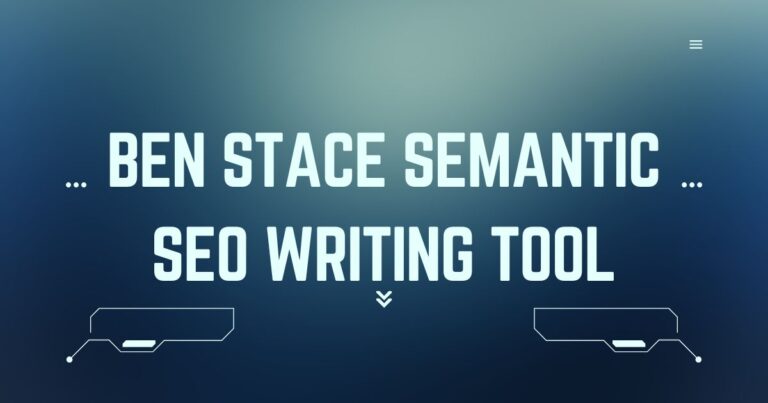
In today’s rapidly evolving digital ecosystem, traditional keyword-centric strategies are no longer sufficient to dominate search engine rankings. This shift has brought semantic SEO into the spotlight—a methodology that focuses on search intent, contextual relevance, and topic clusters. One individual whose work stands out in this field is Ben Stace, whose data-driven research and practical implementations have shaped how many view modern SEO. The Ben Stace semantic SEO case studies offer deep insights into how leveraging semantic principles can significantly improve visibility, engagement, and traffic.
This article explores Ben Stace’s groundbreaking work, the essence of semantic SEO, and how his case studies can guide both agencies and brands toward sustainable digital success.
Who is Ben Stace?
Ben Stace is a renowned SEO consultant and strategist, recognized for his analytical approach to organic search growth and his emphasis on semantically rich content structures. With over a decade of experience in technical SEO, content optimization, and entity-based search modeling, Stace has developed a portfolio of real-world examples that demonstrate the power of semantic SEO in action.
The Ben Stace semantic SEO case studies have been cited by marketers, educators, and digital agencies for their practical value and clear, measurable outcomes.
Also, explore Tecnoregio News: Your Source for Innovation and Technology Updates
What is Semantic SEO?
Semantic SEO involves optimizing content to be more meaningful and contextually relevant to users, not just machines. Unlike traditional SEO that focuses solely on keywords, semantic SEO emphasizes:
- Search intent alignment
- Topic modeling and content clustering
- Use of structured data (schema markup)
- Natural language processing (NLP)
- Entity recognition and relationship mapping
Through the Ben Stace semantic SEO case studies, readers can see how these principles are applied to improve content depth, internal linking, and SERP visibility.
Highlights from Ben Stace Semantic SEO Case Studies
1. E-commerce Expansion via Topic Clustering
One notable case study from Ben Stace involved an e-commerce client with a large but underperforming product catalog. By implementing semantic keyword mapping and grouping content into intent-based clusters, organic sessions increased by 78% within five months.
2. Boosting Topical Authority for SaaS Companies
In another study, a SaaS brand used semantic content modeling to build interconnected blog posts and landing pages. Structured internal linking and rich snippet optimization led to a 50% increase in keyword rankings for high-value terms.
3. Improving Featured Snippet Presence
Stace’s work with a news publishing site shows how optimizing for contextual questions, long-tail variations, and user behavior patterns led to a 3x improvement in featured snippet acquisition across hundreds of articles.
4. Healthcare Content Optimization
Using natural language generation tools and semantic mapping, a healthcare site achieved a 65% rise in visibility for condition-based searches. The approach focused on entity-based relevance rather than keyword stuffing.
5. Local SEO With Semantic Enrichment
By enhancing local business pages with structured data, contextual FAQs, and related services sections, one of the case studies demonstrated a 120% lift in impressions on Google Maps and local packs.
These Ben Stace semantic SEO case studies prove that semantic strategies don’t just improve rankings—they enhance content quality and user trust.
Frequently Asked Questions
1. What makes the Ben Stace semantic SEO case studies unique?
They focus on practical implementation, measurable KPIs, and real-world scenarios where semantic strategies produced tangible results across multiple industries.
2. Are semantic SEO practices suitable for small businesses?
Yes. While semantic SEO is complex, Ben Stace demonstrates how even small businesses can use topic clustering, structured data, and intent mapping to compete effectively.
3. Can these strategies work without technical SEO knowledge?
Basic understanding helps, but many tools today simplify semantic SEO tasks. Following insights from Ben Stace semantic SEO case studies offers step-by-step frameworks even for non-experts.
4. How long does it take to see results using semantic SEO?
Most case studies show results within 3 to 6 months, depending on competition and content volume.
5. Where can I find more of Ben Stace’s SEO work?
Ben Stace shares content through his website, webinars, and SEO publications. His case studies are often referenced in industry blogs and professional SEO training programs.
Conclusion
The Ben Stace semantic SEO case studies are not just theoretical; they’re detailed blueprints showing how semantic thinking can reshape digital marketing outcomes. Whether you’re a business owner, SEO practitioner, or digital strategist, adopting semantic SEO practices—such as entity optimization, content clustering, and structured data implementation—is no longer optional but essential. As search engines evolve to prioritize user intent and contextual relevance, Ben Stace’s work offers a clear path to long-term SEO success.






